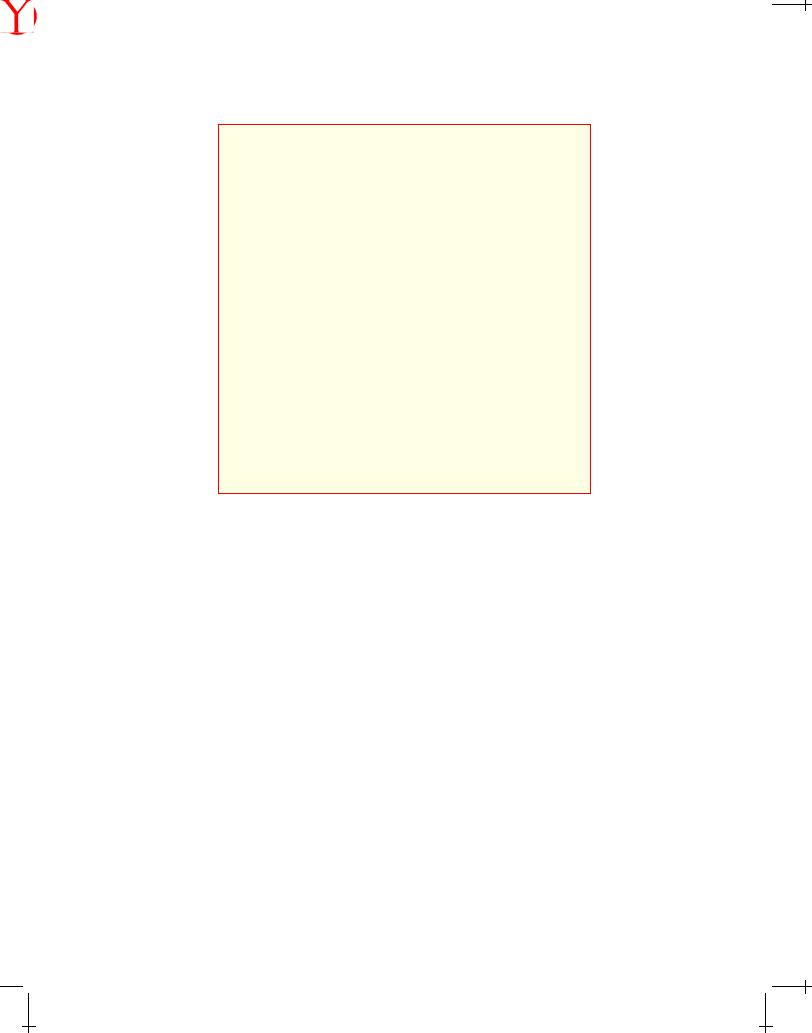
B.Thide - Electromagnetic Field Theory
.pdf






ϒ
Bo Thidé
U p s i l o n |
B o o k s |
i
i |
i |

i
i |
i |

ϒ
ELECTROMAGNETIC FIELD THEORY
Bo Thidé
i
i |
i |

Also available
ELECTROMAGNETIC FIELD THEORY
EXERCISES
by
Tobia Carozzi, Anders Eriksson, Bengt Lundborg,
Bo Thidé and Mattias Waldenvik
i
i |
i |

ELECTROMAGNETIC
FIELD THEORY
Bo Thide´
Swedish Institute of Space Physics
and
Department of Astronomy and Space Physics
Uppsala University, Sweden
and
School of Mathematics and Systems Engineering
Vaxj¨ o¨ University, Sweden
ϒ
Upsilon Books Communa AB Uppsala Sweden
i
i |
i |

This book was typeset in LATEX 2" (based on TEX 3.14159 and Web2C 7.3.9) on an HP Visualize 9000/360 workstation running HP-UX 11.11.
Copyright ©1997, 1998, 1999, 2000, 2001 and 2002 by
Bo Thidé
Uppsala, Sweden
All rights reserved.
Electromagnetic Field Theory
ISBN X-XXX-XXXXX-X
i
i |
i |

Contents
Preface |
xi |
1 Classical Electrodynamics |
1 |
1.1 Electrostatics . . . . . . . . . . . . . . . . . . . . . . . . . . . |
2 |
1.1.1 Coulomb's law . . . . . . . . . . . . . . . . . . . . . . |
2 |
1.1.2The electrostatic field . . . . . . . . . . . . . . . . . . . 3
1.2 Magnetostatics . . . . . . . . . . . . . . . . . . . . . . . . . . 6
1.2.1Ampère's law . . . . . . . . . . . . . . . . . . . . . . . 6
1.2.2The magnetostatic field . . . . . . . . . . . . . . . . . . 7
1.3 Electrodynamics . . . . . . . . . . . . . . . . . |
. . . . . . . . |
9 |
|
1.3.1 |
Equation of continuity for electric charge |
. . . . . . . . 10 |
|
1.3.2 |
Maxwell's displacement current . . . . . |
. . . . . . . . |
10 |
1.3.3Electromotive force . . . . . . . . . . . . . . . . . . . . 11
1.3.4Faraday's law of induction . . . . . . . . . . . . . . . . 12
1.3.5 Maxwell's microscopic equations . . . . . . . . . . . . 15
1.3.6Maxwell's macroscopic equations . . . . . . . . . . . . 16
1.4 |
Electromagnetic Duality . . . . . . . . . . . . . . . . . . . . . |
16 |
|
|
Example 1.1 Faraday's law as a consequence of conserva- |
|
|
|
tion of magnetic charge . . . . . . . . . . . . . |
18 |
|
|
Example 1.2 |
Duality of the electromagnetodynamic equations 19 |
|
|
Example 1.3 Dirac's symmetrised Maxwell equations for a |
|
|
|
fixed mixing angle . . . . . . . . . . . . . . . . 20 |
||
|
Example 1.4 |
The complex field six-vector . . . . . . . . . |
21 |
|
Example 1.5 |
Duality expressed in the complex field six-vector 22 |
|
Bibliography . . . . . . . . . . . . . . . . . . . . . . . . . . . . . . |
23 |
||
2 Electromagnetic Waves |
|
25 |
|
2.1 |
The Wave Equations . . . . . . . . . . . . . . . . . . . . . . . |
26 |
|
2.1.1The wave equation for E . . . . . . . . . . . . . . . . . 26
2.1.2The wave equation for B . . . . . . . . . . . . . . . . . 26
2.1.3 The time-independent wave equation for E . . . . . |
. |
. |
27 |
Example 2.1 Wave equations in electromagnetodynamics |
. |
. |
28 |
2.2Plane Waves . . . . . . . . . . . . . . . . . . . . . . . . . . . . 30
2.2.1 Telegrapher's equation . . . . . . . . . . . . . . . . . . 31
2.2.2Waves in conductive media . . . . . . . . . . . . . . . . 32
i
i
i |
i |

ii |
CONTENTS |
2.3 Observables and Averages |
. . . . . . . . . . . . . . . . |
. . |
. |
. |
34 |
Bibliography . . . . . . . . . |
. . . . . . . . . . . . . . . . . |
. . |
. |
. |
35 |
3 Electromagnetic Potentials |
|
|
|
|
37 |
3.1The Electrostatic Scalar Potential . . . . . . . . . . . . . . . . . 37
3.2The Magnetostatic Vector Potential . . . . . . . . . . . . . . . . 38
3.3The Electrodynamic Potentials . . . . . . . . . . . . . . . . . . 38
3.3.1Electrodynamic gauges . . . . . . . . . . . . . . . . . . 40 Lorentz equations for the electrodynamic potentials . . . 40 Gauge transformations . . . . . . . . . . . . . . . . . . 41
3.3.2Solution of the Lorentz equations for the electromag-
netic potentials . . . . . . . . . . . . . . . |
. . . . . . . 42 |
||||
The retarded potentials . . . . . . . . . . . . . . . . . . 46 |
|||||
Example 3.1 Electromagnetodynamic potentials |
. . |
. . |
. |
. |
46 |
Bibliography . . . . . . . . . . . . . . . . . . . . . . . |
. . . |
. . |
. |
. |
47 |
4 Relativistic Electrodynamics |
|
|
|
|
49 |
4.1The Special Theory of Relativity . . . . . . . . . . . . . . . . . 49
4.1.1 The Lorentz transformation . . . . . . . . . . . . . . . 50
4.1.2Lorentz space . . . . . . . . . . . . . . . . . . . . . . . 51 Radius four-vector in contravariant and covariant form . 52
Scalar product and norm . . . . . . . . . . . . . |
. . . . 52 |
|||
Metric tensor . . . . . . . . . . . . . . . . . . . |
. . |
. |
. |
53 |
Invariant line element and proper time . . . . . . |
. . |
. |
. |
54 |
Four-vector fields . . . . . . . . . . . . . . . . . . . . . 56
The Lorentz transformation matrix . . |
. . . . . . |
. . |
. |
. |
56 |
The Lorentz group . . . . . . . . . . |
. . . . . . |
. . |
. |
. |
56 |
4.1.3 Minkowski space . . . . . . . . . . . . . . . . . . . . . 57
4.2Covariant Classical Mechanics . . . . . . . . . . . . . . . . . . 59
4.3Covariant Classical Electrodynamics . . . . . . . . . . . . . . . 61
4.3.1 The four-potential . . . . . . . . . . . . . . . . . . . . 61
4.3.2The Liénard-Wiechert potentials . . . . . . . . . . . . . 62
4.3.3The electromagnetic field tensor . . . . . . . . . . . . . 64
Bibliography . . . . . . . . . . . . . . . . . . . . |
. . . . . . . . . . 67 |
5 Electromagnetic Fields and Particles |
69 |
5.1Charged Particles in an Electromagnetic Field . . . . . . . . . . 69
5.1.1Covariant equations of motion . . . . . . . . . . . . . . 69
Lagrange formalism . . . . |
. . |
. . . . . . . . . |
. . |
. |
. |
70 |
Hamiltonian formalism . . . |
. . |
. . . . . . . . . |
. . |
. |
. |
72 |
Downloaded from http://www.plasma.uu.se/CED/Book |
Draft version released 31st October 2002 at 14:46. |
i
i |
i |

iii
5.2Covariant Field Theory . . . . . . . . . . . . . . . . . . . . . . 76
5.2.1Lagrange-Hamilton formalism for fields and interactions 76 The electromagnetic field . . . . . . . . . . . . . . . . . 80
Example 5.1 Field energy difference expressed in the field tensor . . . . . . . . . . . . . . . . . . . . . . 81
Other fields . . . . . . . . . . |
. . . . . . |
. . . |
. . . |
. |
. |
84 |
|
Bibliography . . . . . . . . . . . . . . |
. . |
. . . . . . |
. . . |
. . . |
. |
. |
85 |
6 Electromagnetic Fields and Matter |
|
|
|
|
|
|
87 |
6.1Electric Polarisation and Displacement . . . . . . . . . . . . . . 87
6.1.1 Electric multipole moments . . . . . . . . . . . . . . . 87
6.2Magnetisation and the Magnetising Field . . . . . . . . . . . . . 90
6.3Energy and Momentum . . . . . . . . . . . . . . . . . . . . . . 92
6.3.1 The energy theorem in Maxwell's theory . . . . . . . . 92
6.3.2The momentum theorem in Maxwell's theory . . . . . . 93
Bibliography . . . . . . . . . . . . . . . . . . . . . . . . . . . . |
. . 95 |
7 Electromagnetic Fields from Arbitrary Source Distributions |
97 |
7.1The Magnetic Field . . . . . . . . . . . . . . . . . . . . . . . . 99
7.2The Electric Field . . . . . . . . . . . . . . . . . . . . . . . . . 101
7.3 The Radiation Fields . . . . . . . . . . . . . . . . . . . . . . . 103
7.4Radiated Energy . . . . . . . . . . . . . . . . . . . . . . . . . . 106 7.4.1 Monochromatic signals . . . . . . . . . . . . . . . . . . 106
7.4.2 Finite bandwidth signals . . . . . . . . . . . . . . . |
. . |
107 |
Bibliography . . . . . . . . . . . . . . . . . . . . . . . . . . . . |
. . |
108 |
8 Electromagnetic Radiation and Radiating Systems |
|
109 |
8.1 Radiation from Extended Sources . . . . . . . . . . . . . . |
. . |
109 |
8.1.1 Radiation from a one-dimensional current distribution |
. 110 |
|
8.1.2 Radiation from a two-dimensional current distribution |
. 113 |
|
8.2Multipole Radiation . . . . . . . . . . . . . . . . . . . . . . . . 116 8.2.1 The Hertz potential . . . . . . . . . . . . . . . . . . . . 116
8.2.2 |
Electric dipole radiation |
. . . . . . . . . |
. . . |
. . . |
. |
. |
120 |
8.2.3 |
Magnetic dipole radiation |
. . . . . . . . |
. . . |
. . . |
. |
. |
122 |
8.2.4Electric quadrupole radiation . . . . . . . . . . . . . . . 123
8.3Radiation from a Localised Charge in Arbitrary Motion . . . . . 124
8.3.1The Liénard-Wiechert potentials . . . . . . . . . . . . . 125
8.3.2 Radiation from an accelerated point charge . . . . . . . 127
The differential operator method . . . . . . . . . . . . |
. |
129 |
Example 8.1 The fields from a uniformly moving charge . |
. |
134 |
Draft version released 31st October 2002 at 14:46. |
Downloaded from http://www.plasma.uu.se/CED/Book |
i
i |
i |

iv |
CONTENTS |
Example 8.2 The convection potential and the convection force136
Radiation for small velocities . . . . . . . . . . . . . . 139
8.3.3Bremsstrahlung . . . . . . . . . . . . . . . . . . . . . . 140
Example 8.3 Bremsstrahlung for low speeds and short acceleration times . . . . . . . . . . . . . . . . . 143
8.3.4Cyclotron and synchrotron radiation . . . . . . . . . . . 145 Cyclotron radiation . . . . . . . . . . . . . . . . . . . . 147 Synchrotron radiation . . . . . . . . . . . . . . . . . . . 148 Radiation in the general case . . . . . . . . . . . . . . . 150
|
|
Virtual photons . . . . . . . . . . . . . . . . . . . . . . 151 |
||
|
8.3.5 |
Radiation from charges moving in matter . . . . . . . . 153 |
||
|
|
ˇ |
|
155 |
|
|
Vavilov-Cerenkov radiation . . . . . . . . . . . . . . . |
||
Bibliography |
. . . . . . . . . . . . . . . . . . . . . . . . . . . . . . 160 |
|||
F Formulae |
|
|
161 |
|
F.1 |
The Electromagnetic Field . . . . . . . . . . . . . . . . . . . . |
161 |
||
|
F.1.1 |
Maxwell's equations . . . . . . . . . . . . . . . . . . . |
161 |
|
|
|
Constitutive relations . . . . . . . . . . . . . . . . . . . 161 |
||
|
F.1.2 |
Fields and potentials . . . . . . . . . . . . . . . . . . . |
161 |
|
|
|
Vector and scalar potentials . . . . . . . . . . . . . . . |
161 |
|
|
|
Lorentz' gauge condition in vacuum |
. . . . . . . . . . . 162 |
|
|
F.1.3 |
Force and energy . . . . . . . . . . . . . . . . . . . . . |
162 |
|
|
|
Poynting's vector . . . . . . . . . . . . . . . . . . . . . 162 |
||
|
|
Maxwell's stress tensor . . . . . . . . . . . . . . . . . . 162 |
||
F.2 |
Electromagnetic Radiation . . . . . . . . . . . . . . . . . . . . |
162 |
||
|
F.2.1 |
Relationship between the field vectors in a plane wave . 162 |
||
|
F.2.2 |
The far fields from an extended source distribution . . . 162 |
||
|
F.2.3 |
The far fields from an electric dipole . . . . . . . . . . . |
162 |
|
|
F.2.4 |
The far fields from a magnetic dipole |
. . . . . . . . . . 163 |
|
|
F.2.5 |
The far fields from an electric quadrupole . . . . . . . . 163 |
||
|
F.2.6 |
The fields from a point charge in arbitrary motion . . . . 163 |
||
F.3 |
Special Relativity . . . . . . . . . . . . . . . . . . . . . . . . . |
163 |
||
|
F.3.1 |
Metric tensor . . . . . . . . . . . . . . . . . . . . . . . |
163 |
|
|
F.3.2 |
Covariant and contravariant four-vectors . . . . . . . . . |
164 |
|
|
F.3.3 |
Lorentz transformation of a four-vector . . . . . . . . . |
164 |
|
|
F.3.4 Invariant line element . . . . . . . . . . . . . . . . . . . 164 |
|||
|
F.3.5 |
Four-velocity . . . . . . . . . . . . . . . . . . . . . . . |
164 |
|
|
F.3.6 |
Four-momentum . . . . . . . . . . . . . . . . . . . . . |
164 |
|
|
F.3.7 |
Four-current density . . . . . . . . . . . . . . . . . . . |
164 |
|
|
F.3.8 Four-potential . . . . . . . . . . . . . . . . . . . . . . . 164 |
|||
Downloaded from http://www.plasma.uu.se/CED/Book |
Draft version released 31st October 2002 at 14:46. |
i
i |
i |
